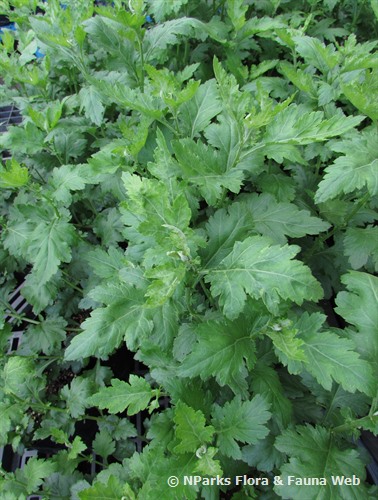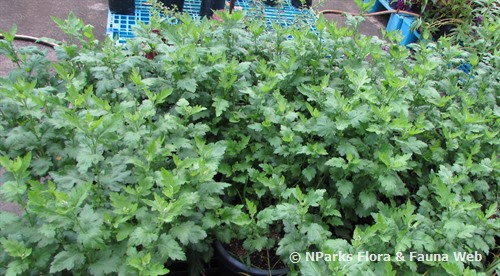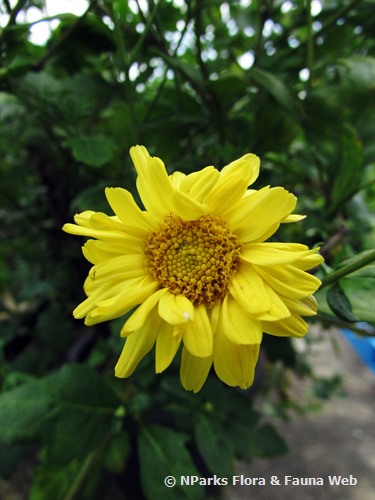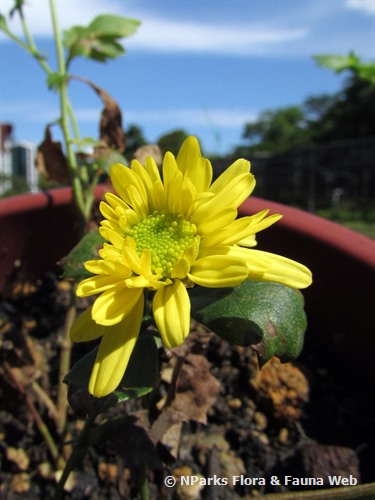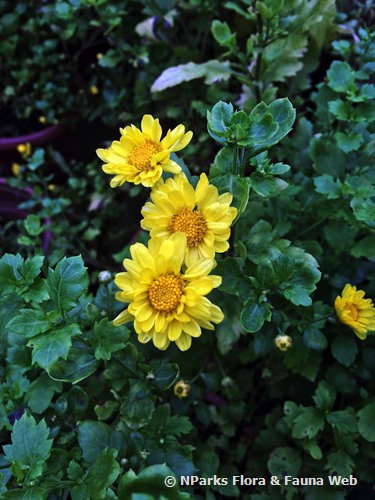
Back
Chrysanthemum × morifolium (Ramat.) Hemsl.
| Family Name: | Asteraceae (Compositae) |
| Common Name: | Chrysanthemum, Mums, Kekwa, 菊花 |
Name
Classifications and Characteristics
| Plant Division | Angiosperms (Flowering Seed Plants) (Dicotyledon) |
|---|---|
| Plant Growth Form | Herbaceous Plant, Shrub |
| Lifespan (in Singapore) | Perennial |
| Mode of Nutrition | Autotrophic |
| Maximum Height | 0.3 m to 0.9 m |
| Maximum Plant Spread / Crown Width | 0.3 m to 0.6 m |
Biogeography
| Native Distribution | China. Introduced as an ornamental to North and South America, Europe, Asia, Australia and South Africa. |
|---|---|
| Native Habitat | Terrestrial |
| Preferred Climate Zone | Tropical |
| Local Conservation Status | Non-native (Horticultural / Cultivated Only) |
Description and Ethnobotany
| Growth Form | Perennial herbaceous hybrid up to 1 m tall. Stem becomes woody at the base over time. |
|---|---|
| Foliage | Leaves are pubescent (covered with fine hair), olive green, have petioles of 1 - 2 cm long. Leaf blade is ovate to oblong ovate, measuring 4 - 10 cm by 3 - 5 cm, deeply lobed. Base is truncate to subcordate. |
| Stems | Stems are erect or ascending, sometimes procumbent. They are sparsely branched. |
| Flowers | Inflorescence is a head composed of many ray and disk florets. This plant needs short days to flower. In Singapore, it may be difficult to get a plant to flower again after the flowers fade. |
| Taxonomy | This hybrid is formed by crossing the following species: Chrysanthemum argyrophyllum x Chrysanthemum dichrum x Chrysanthemum indicum x Chrysanthemum nankingense x Chrysanthemum zawadzkii. |
| Cultivation | This plant prefers cool climate and requires to be grown in areas with mean temperature of 16 - 24 degree Celsius. Grow in fertile, moist and well-drained soil rich with organic matter. Allow the soil to dry between watering. Avoid watering from above to avoid the risk of diseases. Pinch the tips when plant is about 15 cm tall to promote bushiness. |
| Etymology | The genus Chrysanthemum means golden-flower. The specific epithet morifolium means mulberry-leaved, in reference to the leaf shape that looks like those of mulberry. |
| Ethnobotanical Uses | Food (Fruit or Vegetable) |
Landscaping Features
| Desirable Plant Features | Ornamental Flowers |
|---|---|
| Landscape Uses | Small Gardens, Flowerbed / Border, Container Planting, Interiorscape/ Indoor Plant |
| Usage Hazard - Cons Remarks | This plant may be toxic to pets, such as cats. |
Plant Care and Propagation
| Light Preference | Full Sun |
|---|---|
| Water Preference | Moderate Water |
| Plant Growth Rate | Fast |
| Rootzone Tolerance | Moist Soils, Well-Drained Soils, Fertile Loamy Soils |
| Potential Problems | Easily infested by aphids and white flies. |
| Diseases | White Rust. Symptoms include white to yellow spots on undersides of leaves. |
| Pest(s) | Sucking Insects |
| Propagation Method | Stem Cutting |
Foliar
| Foliage Retention | Evergreen |
|---|---|
| Mature Foliage Colour(s) | Green |
| Mature Foliage Texture(s) | Velvety / Furry / Tomentose |
| Prominent Young Flush Colour(s) | Green |
| Young Flush Texture(s) | Velvety / Furry / Tomentose |
| Foliar Type | Simple / Unifoliate |
| Foliar Arrangement Along Stem | Alternate |
| Foliar Attachment to Stem | Petiolate |
| Foliar Shape(s) | Non-Palm Foliage |
| Foliar Venation | Pinnate / Net |
| Foliar Margin | Pinnately Lobed / Pinnatifid |
| Foliar Apex - Tip | Acute |
| Foliar Base | Truncate / Square, Cordate |
Floral (Angiosperm)
| Flower & Plant Sexuality | Bisexual Flowers |
| Flower Colour(s) | Cream / Off-White, Yellow / Golden |
|---|---|
| Flower Grouping | Solitary |
| Flower Location | Axillary |
| Flower Symmetry | Radial |
| Inflorescence Type | Compound Head / Capitulum |
References
| References | <1> Li, L., Gu, L., Chen, Z., Wang, R., Ye, J. & Jiang, H. (2010). Toxicity study of ethanolic extract of Chrysanthemum morifolium in rats. J Food Sci. 75(6):105-109. |
|---|
Image Repository
Others
| Master ID | 33604 |
|---|---|
| Species ID | 8018 |
| Flora Disclaimer | The information in this website has been compiled from reliable sources, such as reference works on medicinal plants. It is not a substitute for medical advice or treatment and NParks does not purport to provide any medical advice. Readers should always consult his/her physician before using or consuming a plant for medicinal purposes. |

